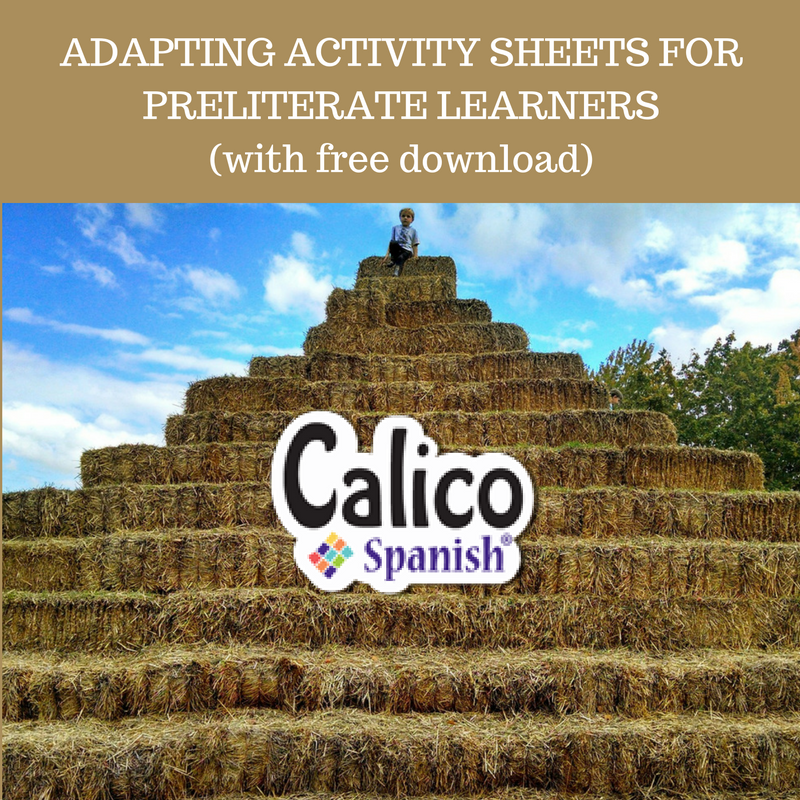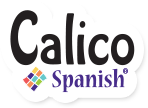Adapting “worksheets” for preliterate learners (FREE activity sheet!)
 How can an activity sheet that requires writing be made effective for kids who can’t read or write?
How can an activity sheet that requires writing be made effective for kids who can’t read or write?
Multi-sensory is certainly the way to go when teaching all ages of learners, but especially very young ones. Games? Yes! Songs? Oh, yeah! Play-doh? Why not? Children learn language better when they can experience it in many ways, when they can see it, sing it, hear it, say it, draw it, write it, feel it.
Enter activity sheets. We “progressive” teachers use the word “worksheet” as if it were the plague of modern education, but the truth is, the problem is not in the tool, but in its purpose and design. If a worksheet is designed to get kids making meaning in the language, it can be a golden opportunity for experiencing language learning. If it’s asking children to fill in the correct gender of pronoun in front of words taken out of any meaningful context, just about every expert in the field will label that a waste of your learners’ precious acquisition time.
But if you teach very young learners, you have an additional problem: many activity sheets are designed to require at least a little bit of reading and writing. What can you do if your learners are preliterate? Here we’ll offer you a free activity sheet from Level A of Calico Spanish’s online Homeschool and Stories for Schools programs and use it to give you a few quick tips on adjusting for learners who are just learning to read and write.
This Activity Sheet is one of three that are part of Lesson 2, “Hola, ¡soy grande!” in which children:
- meet María la mona
- learn to give their age, and
- learn describe something as grande or pequeño.
Children are asked to count the candles on the cakes to find out how old the Stories characters are. Learners are supposed to write “Tengo _____ años” in the speech bubbles to help the characters answer the boy’s question.
Let’s take a look at the two things that may need modifying for preliterate learners in any worksheet: input and output.
 Input
Input
The input portion here is easy because of the engaging design on this Activity Sheet; children aren’t looking at a number, they’re looking at a number of candles. So the input piece is not an issue. But if it were, you’d simply support the children with a projected copy you read to them. Here, you’ll need to help them read the characters’ names.
Also, don’t forget to maximize the learning: point out any features that children are learning in either language. It’s not going to hurt their Spanish learning if you let them point out Camilo’s “C for ca- ca- camilo” and it’s not going to hurt their English literacy development if you’ve fostered a high-TL-percentage environment and you point out Camilo’s “C es para ca- ca- Camilo.” Last week you should have seen how proud my four-year-olds were that they were “reading in Spanish” because they read the word no every time we encountered it in one of our Storybooks! One of the moms was in the room and was both highly amused that the children believed they were suddenly reading “in Spanish” and impressed that they were working on real literacy in their Spanish time.
 Output
Output
What about when it’s time to do something with the language besides receive it? Activity sheets usually ask children to write something (although several of our Level A and B Activity Sheets ask children to simply circle the item that is grande or draw several items that are usually azul). There are a few ideas you can use to still use a good activity sheet that asks children to write, as this birthday cake one does.
First, ask yourself if children can draw something to show comprehension. Can very young children draw as many circles or stars as there are candles on the cakes and then tell you how many of each there are?
Second, if children aren’t ready to use numbers, you can ask for simple tally marks to replace them (i.e. there are three candles, draw three lines).
Third, ditch the concept of writing anything and turn the sheet into a role play. Assign one child the role of the boy (in Calico Spanish Homeschool / Stories Level A, Lesson 1, his name is Carlos). Other children play the part of our Stories characters. “Carlos” asks each one, “¿Cuántos años tienes?” and they respond with the appropriate number or longer response.
When I recently used this worksheet with my early-literate four-year-olds, I had to just sit back and wonder at them contemplating the task. One little girl circled each candle as she counted them in Spanish and then would say to herself, “He only has dos so he can’t say he’s grande,” and then she’d draw a big X over him. Yes, half of what she said was in English, but did you catch that she was using the language in context to make meaning? That’s a quality learning experience!
Don’t forget to download your FREE PDF of this Activity Sheet and try it with your early language learners. How will they use it to make meaning?
(For more related to this topic, see TPRS expert Kristy Placido’s fantastic post “In defense of worksheets and packets.”)
Do you have any other tips for adapting activity sheets for very young learners?





No Comments